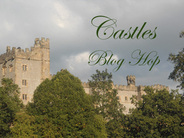 Today, I'm taking part in a "blog hop" celebrating the launch of Castles, Customs and Kings, a compilation of essays from the English Historical Fiction Authors blog. If you go to the blog, you can enter for a chance to win a free copy! "Read the history behind the fiction and discover the true tales surrounding England's castles, customs, and kings." --Official excerpt 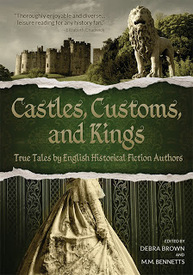 I have a piece in here about the political activities of Quaker women, who spent a lot of time speaking against the King. But today, since a number of bloggers are discussing palaces and castles, I thought I would write about my personal experience living near the ruins of Winchester Palace in London. *********************************************************************************** 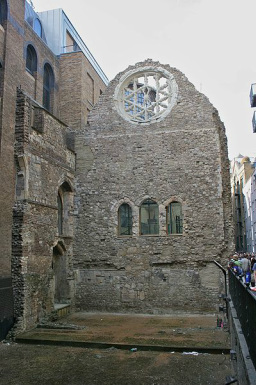 Photo: Mike Peel. 2009. www.mikepeel.net Photo: Mike Peel. 2009. www.mikepeel.net When I was a pirate serving aboard the Golden Hinde, the museum replica of Sir Francis Drake's ship dry-docked in the Thames--(okay, I was a tour guide or 'living history interpreter')--I spent a lot of time gazing at the ruins of Winchester Palace. Located in Southwark, near Shakespeare's Globe, the Clink and the Anchor (most fun pub in London), the ruins of the 13th century Winchester Palace loom incongruously from a modern parking garage (Car park!) 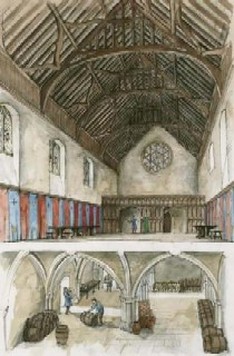 Liam Wales © Eng. Her. Photo Library Liam Wales © Eng. Her. Photo Library Not to be confused with the more illustrious Winchester Castle--or Winchester Cathedral, as many a dismayed tourist has done—Winchester Palace was founded by Bishop Henry de Blois, brother of King Stephen, in the early 13th century. It was designed to serve as a place for visiting bishops to stay when they journeyed to London. According to the English Heritage website, the Palace once consisted of a Great Hall, which led to a buttery, pantry and kitchen. In its late medieval heyday, the Palace had been a site of great spectacle, feasts and grand dinners, even have hosted the wedding dinner of James I of Scotland and Joan Beauford in 1424. The majestic qualities of the palace are suggested by the presence of a rose window, a common feature of more lavish churches and palaces built in this time. There is also evidence that the palace had a tennis court, bowling alley and pleasure gardens, to keep the bishops entertained while on royal and administrative business. Underneath the hall was a vaulted wine cellar, no doubt full of great vats and bottles to keep the bishops and their guests merry. There was also a passageway to the river wharf along the south bank of the Thames, to bring supplies into the Palace. The palace seems to have been surrounded around two courtyards, a brew-house and butchery. The Clink prison, under the auspices of the Bishop of Winchester, was also nearby. (Yes, this is where we get the phrase being ‘thrown in the clink.’) 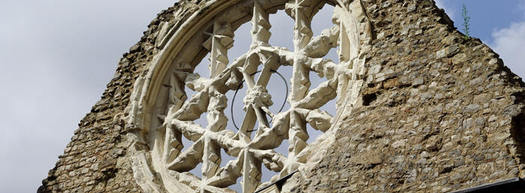 The Rose Window http://www.english-heritage.org.uk The Rose Window http://www.english-heritage.org.uk After the Reformation and King Henry VIII’s dissolution of many church properties, the palace changed its purpose. By the 17th century it was divided into tenements and warehouses. In the 19th century, much of the palace was destroyed in a fire in 1814. The ruins remained in disrepair until the 1980s when the area began to be redeveloped. Now only the bare remains and beautiful rose window suggest the former grandeur of the Palace. When I used to lead school children on tours of the ship, we’d often pause by the Palace ruins. There, I couldn’t help but whisper about the mysterious happenings the Golden Hinde crew had all witnessed during our long moonlit stints on ship watch... A shadow moving slowly through the grounds, when the source of the movement could not be detected.... A flock of black birds, arrayed in a perfect circle, as if convened at a great table.... And most odd of all: one night, our whole crew heard the strands of a madrigal being sung from deep within the ruins...By the time one of us mustered up the courage to peer over the guardrail, the unknown singers had vanished. To this day, I sometimes wonder who those anonymous singers were... But that's the intriguing romance and mystery of the ruins of Winchester Palace....
16 Comments
I'm joined on my blog today by award-winning author, Anna Lee Huber. I had the pleasure of meeting this talented writer, last year at Bouchercon, during a signing for new authors. On Saturday September 14, Anna and I will be doing a joint signing at Centuries and Sleuths in Forest Park, IL at 11:00. Hope to see you there! ********************************************************************************** 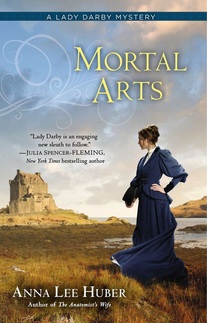 Love the title of Anna's 2nd book! Love the title of Anna's 2nd book! Scotland, 1830. Lady Kiera Darby is no stranger to intrigue-in fact, it seems to follow wherever she goes. After her foray into murder investigation, Kiera must journey to Edinburgh with her family so that her pregnant sister can be close to proper medical care. But the city is full of many things Kiera isn't quite ready to face: the society ladies keen on judging her, her fellow investigator-and romantic entanglement-Sebastian Gage, and ultimately, another deadly mystery. Kiera's old friend Michael Dalmay is about to be married, but the arrival of his older brother-and Kiera's childhood art tutor-William, has thrown everything into chaos. For ten years Will has been missing, committed to an insane asylum by his own father. Kiera is sympathetic to her mentor's plight, especially when rumors swirl about a local girl gone missing. Now Kiera must once again employ her knowledge of the macabre and join forces with Gage in order to prove the innocence of a beloved family friend-and save the marriage of another... ********************************************************************************** 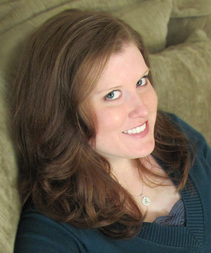 the talented Anna Lee Huber the talented Anna Lee Huber Thanks for joining us today! Mortal Arts, the second in your series featuring Lady Kiera Darby, is set in Scotland in 1830. What made you choose this particular place and time? When I decided to write a historical mystery series with a heroine who has some knowledge of anatomy, I knew 1830 would be the perfect time period. It’s just after the trial of Burke and Hare, two body snatchers-turned-murderers, which plays into the public’s fear of Kiera once news of her involvement with her late husband’s dissections comes to light, and it’s just a few years before the Anatomy Act of 1832. Not to mention all of the other reforms being made with the Catholic Act of 1829, the Reform Act of 1832, the beginnings of the building of railroads, the ramping up of industrialization. It’s a very interesting period. Lots of conflict. Could you also tell us a little about what inspired you? I have difficulty pinpointing exactly what first inspired me to write the Lady Darby novels. I was very deliberate in choosing the genre, and I crafted Kiera’s backstory to give her the investigative skills I wanted her to have, and the rest of her history was created from the consequences of that. The plot of Book 1, The Anatomist’s Wife, even grew from that. I chose to set it in the Scottish Highlands because I needed an isolated location. I tell people that Kiera feels like she’s always been there, in the back of my mind, and I think it’s true. From the very first, even before I knew who she was, I could hear her voice very clearly in my writing. So perhaps that’s why I have trouble deciding on the inspiration. It happened when I wasn’t paying attention. Lady Darby has been described as “an unusual and romantic heroine.” What makes her so unusual? Is she someone you would want to be friends with? First of all, she’s a gifted portrait artist, determined to pursue her art—something not very common for a woman in her time. She has the ability to lose herself in her art, and to see to the heart of the person she is painting, which often unnerves people, even as it makes her portraits special. Even more startling, she was forced to assist her late husband, who was a famous anatomist and surgeon to royalty, with his dissections, sketching them because he did not wish to split the credit for his anatomy textbook with an illustrator. So she has knowledge of anatomy that she’s unwillingly collected. When the scandal broke over her involvement with her husband’s work, society and the general public vilified her, concocting all sorts of gruesome rumors about her. Her standoffish demeanor and quiet reserve do not help matters. She is not comfortable in society or large gatherings, but she is fiercely loyal to those she cares about. She is intelligent, insightful, and witty. I would definitely want her for my friend. Tell us about Sebastian Gage, Lady Darby’s romantic interest. Can you give us a hint as to which actor you would cast to portray him in a film version of the novel? Sebastian Gage is a gentleman inquiry agent who works with his father to help the upper class with their sticky situations. He is charming and extremely attractive, and a bit of a golden boy who is much in demand at society’s gatherings. He also has a reputation as being a bit of a rakehell, but Kiera soon begins to doubt that persona. His true self is somewhat a mystery and he does not share himself easily, which frustrates Kiera to no end. If I got to cast Gage, I would choose someone like Rupert Penry-Jones. He was fabulous as Captain Wentworth in the BBC version of Jane Austen’s Persuasion. (Hmmm...me likes!) 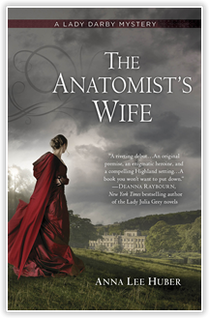 Anna's award-winning first book Anna's award-winning first book What was your favorite part of writing Mortal Arts? My favorite part of writing Mortal Arts was getting to spend more time with the characters I’d created in The Anatomist’s Wife and take them further along on their journey. I love it when they surprise me. Least favorite? My least favorite part was struggling with the doubts and crisis of confidence I had in myself. I had quite a lot of trouble with “imposter syndrome.” There’s this fear, irrational as it may be, that you fooled everyone the first time around. That you truly can’t write. And now you’ll be found out. I constantly had to shore up my belief in myself as a writer. How did writing Mortal Arts compare to writing your debut novel, The Anatomist’s Wife? What was similar about the process? Different? Writing Mortal Arts was my first attempt at writing a sequel, and it was also my first time writing to a publisher’s deadline, both of which added pressure. In one sense it was harder, feeling all of that added pressure, fearing I wouldn’t be able to write another good book. On the other hand, it was also easier. The book was already sold, so all of those worries I felt that I would never be published were no longer there. I’d achieved what I wanted, and that was a huge relief. I had to do more plotting with Mortal Arts. However, I already knew many of the characters, so that was less work. When did you first know you wanted to be a writer? Do you have any manuscripts buried in a drawer somewhere? I first started writing in elementary school, and I have a box full of old stories I wrote then. I moved away from it in high school and then college, but returned to it again after graduation. I wrote four unpublished manuscripts before The Anatomist’s Wife sold. Some of those manuscripts may someday see the light of day, after extensive edits. But others will remain buried on my computer, as they should be. What advice do you have for aspiring writers? First and foremost, never give up. I’m a testament to the power of perseverance. I always say, the only way you are guaranteed not to succeed is if you give up. Second, write, write, write. It’s absolutely the best way to learn. And then find a critique group or a few trusted people who know what they’re doing to help you make your writing better. What’s next? The third Lady Darby novel, A Grave Matter, is scheduled for release in July 2014. I’m finishing that up, and then I want to work on a side project I started a while ago. It’s more of a straight Gothic suspense novel set in Regency England, and I hope to have that polished and ready to go by the end of the year. If it's anything like the first two, it will be another winner! Congrats on your success! ********************************************************************************** Anna Lee Huber is the award-winning author of the Lady Darby historical mystery series. Her debut, The Anatomist’s Wife, has won and been nominated for numerous awards, including two 2013 RITA® Awards and a 2013 Daphne du Maurier Award. Her second novel, Mortal Arts, released September 3rd. She was born and raised in a small town in Ohio, and graduated from Lipscomb University in Nashville, TN with a degree in music and a minor in psychology. She currently lives in Indiana, and enjoys reading, singing, traveling and spending time with her family. Visit her at www.annaleehuber.com. Guest Post in Writer's Digest: Balancing authenticity and accuracy while writing historical fiction9/8/2013 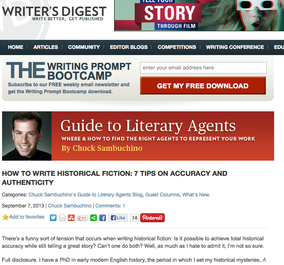 My post in WD appeared Sept 6, 2013 My post in WD appeared Sept 6, 2013 A few years ago, when I was first trying to figure out how to get my debut novel A Murder at Rosamund's Gate published, I came across Writer's Digest. Full of advice for the fledgling writer and published author alike, Writer's Digest gave me some great insights into what I needed to do to polish my manuscript and write a compelling cover letter. (I mean, tell me it's not important to know "How to see your work through an agent or publisher's eyes?" or, "Knowing when to stop: Expectations for a satisfying ending.") So I really appreciated the opportunity to write a guest post, "How to write historical fiction: 7 tips on accuracy and authenticity" for Writer's Digest. In this post, I talk about the tensions I've experienced as a historian-turned-novelist, while writing historical fiction. I also try to offer a few strategies that have worked for me in reconciling these tensions. Check it out! And while you're there, try out the daily writing prompt! Although I have to giggle, because today the prompt is: "You are a local news reporter for a failing network. Your boss tells you to ramp up the news by getting “creative” and constructing your own stories. What’s the first fake news story you create and broadcast on air?" Fake News! Totally fun! Accuracy Shmackeracy! If you do take up the challenge, will you post it here too? I'd love to see it! |
Susanna CalkinsHistorian. Mystery writer. Researcher. Teacher. Occasional blogger. Categories
All
Archives
May 2023
|
 RSS Feed
RSS Feed